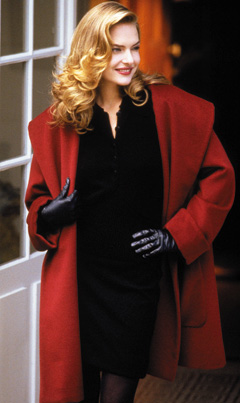|
GOLDSEA |
ASIAMS.NET |
ASIAN AMERICAN WONDER WOMEN
SEAMS COME TRUE
PAGE 2 OF 4
Art, her father deemed, was sheer impracticality and demanded she change her field of study before agreeing to send her to college. Literature was the compromise they struck. At the Tokyo Christian Women's University Mori specialized in the Edo period of Japanese writing, an era known for its peace and development of culture.
Midway through her studies, World War II erupted. Like many students, Mori was forced to toil in a factory. Nights she would hunker down in a bomb shelter. As American shells exploded above, she read Gone with the Wind and other novels about war and romance.
When the fighting stopped, Mori resumed her studies with "an enormous sense of freedom." She graduated in 1947.
Just prior to graduation her plans for entering the professional world were sidetracked when she met the man who would become her husband. He was the son of wealthy textile manufacturer. Upon graduation, they married. Mori began her first career--traditional housewife.
"I had no problem with becoming a housewife," Mori says. "But in three months I became restless, and had begun to want to do something on my own."
Rekindling her artistic aspirations, she began studying fashion design. For two and a half years she pored over the entire process, from concepts to final tailoring.
Confident that she had mastered every facet, Mori opened her first atelier in 1951, a tiny room in Shinjuku where she drew up styles for private clients. Her husband paid the first few months' rent, but within a year the business turned a profit and became self-supporting. Two years later its success surpassed all expectations. Mori's proud husband was pressed into service to supervise the financial side while still overseeing his father's textile factory.
The following year Mori's big break arrived. A Tokyo film producer and art director spotted her designs hanging in a store window and were so impressed with her blend of traditional Asian and contemporary western influences that they dropped by Mori's atelier later that day. Would she create costumes for their upcoming film, they asked.
"They were looking for a freshness," Mori says, "a new manner of dressing women that corresponded with their aesthetic sense."
[CONTINUED BELOW]
For the next six years, from 1954 to 1960, Mori thrived as a costume designer, working on scores of films, collaborating with that era's top Japanese directors like Ozu and Oshima. She created over 700 costumes. In 1960 she received the Japan Editor's Club award for outstanding film costume designs. Amid this creative awakening, she gave birth to two sons.
By the time she had checked the final stitches on her 700th costume, Mori decided she needed a rest. With the small fortune she had saved up from her costume earnings, she wanted to tour Europe and spend more time with her young sons.
"Through working with all these directors," she says, "I broadened my outlook. My eyes were opened to the world. I understood that there were many different types of women, I realized how men looked at women and how they loved them."
PAGE 3
PAGE 1 |
2 |
3 |
4 |
|
|
|
|

<
|
"I understood that there were many different types of women, I realized how men looked at women and how they loved them."
|
CONTACT US
|
ADVERTISING INFO
© 1996-2013 Asian Media Group Inc
No part of the contents of this site may be reproduced without prior written permission.
|







